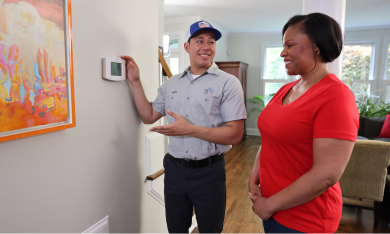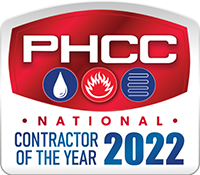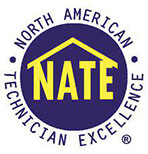

Every homeowner eventually faces a familiar question: should you keep repairing your HVAC system or invest in a full replacement? At first glance, repairs may seem like the less expensive option. However, as systems age and efficiency declines, repair costs can begin to add up faster than you might expect.
The right answer depends on several factors, including your local climate, the age of your equipment, current energy costs, and any available rebates or incentives. These details all help determine when replacement becomes the smarter financial choice. Understanding your break-even point, which is the moment when a replacement begins saving you more money than continued repairs, allows you to plan ahead and make a confident decision.
In this blog, we explain how to calculate your HVAC repair versus replacement break-even point, what local factors influence it, and how to know when upgrading your system is the better long-term investment.
Understanding the Break-Even Point
The break-even point is the moment when replacing your HVAC system becomes more cost-effective than continuing to repair it. Instead of thinking only about the price of a single repair, this analysis considers the long-term costs of keeping an older, less efficient unit versus upgrading to a new high-efficiency system.
To find your break-even point, you need to compare three main factors:
- Repair costs: The total amount you spend on maintenance and emergency service each year.
- System efficiency: Older systems often operate at 60 to 80 percent of their original efficiency, wasting energy and driving up utility bills.
- Replacement cost: The price of installing a new, high-efficiency HVAC system that uses less energy and requires fewer repairs.
When the annual cost of maintaining and operating your current system begins to approach the yearly cost of financing or operating a new unit, you have reached the break-even point. At that stage, replacing your system will save money in the long run.
Another helpful guideline is the “5,000 Rule.” Multiply the cost of a repair by your system’s age. If the total exceeds $5,000, replacement is often the better financial decision.
Understanding where your system falls in this analysis helps you make informed choices rather than reacting to the next breakdown.
Factors That Influence the Repair vs Replace Decision
Deciding whether to repair or replace your HVAC system depends on more than just cost. Several key factors influence the lifespan, performance, and long-term value of your equipment. Understanding each of these can help you make the most cost-effective choice for your home.
- System age: Most HVAC systems last between 12 and 15 years. Once your unit reaches that age, repair costs typically increase while efficiency decreases. If your system is older than a decade and breaking down frequently, replacement is likely the smarter long-term decision.
- Energy efficiency: New systems are significantly more efficient than those installed even 10 years ago. Older equipment often has a lower SEER or SEER2 rating, meaning it consumes more energy to produce the same amount of heating or cooling. Replacing an outdated unit can immediately reduce energy bills.
- Repair frequency: If your HVAC system requires more than two major repairs in a year, it is likely nearing the end of its life. Frequent repairs are a strong indicator that replacement will soon be more economical.
- Local climate: Homes in regions with hot summers or humid conditions, such as much of the southeastern United States, experience heavier HVAC usage. Systems in these areas tend to wear out faster and reach their break-even point sooner.
- Energy and utility costs: Rising energy prices can shift the balance toward replacement. A new high-efficiency system can significantly offset those costs through lower energy consumption.
- Warranty coverage: If your system’s warranty has expired, you are responsible for all repair expenses. Installing a new unit restores warranty protection and provides peace of mind.
Evaluating these factors together gives homeowners a clear picture of whether continued repairs make sense or if it is time to invest in a replacement system that delivers better performance and reliability.
How Climate and Region Affect HVAC Longevity
Where you live plays a major role in how long your HVAC system lasts and how soon you may reach your break-even point for replacement. Different climates create varying levels of strain on heating and cooling equipment, which directly affects wear, efficiency, and repair frequency.
In regions with hot, humid summers, HVAC systems often run for long periods to maintain comfort. Continuous operation causes components such as compressors, coils, and fans to wear out faster. Excess humidity also increases condensation, which can lead to corrosion and mold buildup if not properly managed.
In colder climates, heating systems face their own challenges. Constant cycling during long winters can wear down motors, heat exchangers, and ignition systems. Homes that rely on heat pumps may experience reduced efficiency in subfreezing temperatures, causing additional strain.
Even in moderate climates, outdoor factors like salt air, dust, or pollen can impact performance over time. Proper installation, preventive maintenance, and system sizing all play crucial roles in extending your HVAC system’s lifespan.
Because regional weather directly affects equipment longevity, homeowners should always consider local conditions when evaluating whether to repair or replace their system. A professional inspection can help determine how much life your system realistically has left based on its environment and usage.
When Replacement Delivers Greater Savings
At a certain point, repairing an older HVAC system stops being cost-effective. Even if your current unit can be fixed, it may still cost you more in the long run through higher energy use and repeated service calls. Replacing your system with a high-efficiency model can deliver significant savings while improving comfort and reliability.
Here are key signs that replacement will save you more money:
- Your energy bills are increasing: Older systems lose efficiency each year, forcing them to work harder to produce the same results. A high-efficiency replacement can lower energy consumption by 20 to 40 percent.
- You are scheduling frequent repairs: If you have called for HVAC service several times in the past year, your system is likely near the end of its useful life. Those costs add up quickly.
- Your home has inconsistent temperatures: Uneven heating or cooling often indicates that your system is struggling to keep up with demand, especially in larger homes.
- Your system uses outdated refrigerant: Many older units still rely on phased-out refrigerants, which are expensive and difficult to replace. Newer systems use environmentally friendly refrigerants that improve performance.
- You plan to stay in your home long-term: Investing in a new system now ensures years of comfort and energy savings, while also increasing your home’s resale value.
Modern HVAC systems and heat pumps are designed for higher efficiency, quieter operation, and better humidity control. By replacing an aging unit, homeowners not only reduce repair expenses but also enjoy more consistent indoor comfort throughout the year.
Simple Formula: Estimate Your Own Break-Even Point
While every home and HVAC system is different, you can estimate your own break-even point with a simple calculation. This helps you compare the cost of continued repairs against the value of investing in a new, energy-efficient system.
Use this basic method to get started:
- Add up your average annual repair costs. Include any service calls, parts replacements, and emergency fixes from the past year or two.
- Multiply that number by the age of your system. This gives you a total cost that reflects how much you have already invested.
- Compare that total to the price of a new, high-efficiency unit. If the repair total is close to or exceeds the cost of replacement, your system has likely reached its break-even point.
- Consider energy savings. A new system with a higher SEER2 rating can cut your utility bills by 20 to 40 percent, which shortens the time it takes to recover your investment.
For example, if your system is 12 years old and you spend around $500 each year on repairs, you have already invested about $6,000 in maintenance. If a new, efficient unit costs $8,000 and saves you $500 annually in energy costs, you would recoup the difference in just four years while enjoying better comfort and reliability.
This simplified approach helps homeowners make confident, data-driven decisions rather than guessing when it is time to replace an older HVAC system.
Make the Smart Investment with United Air Temp
Deciding whether to repair or replace your HVAC system is not always easy, but understanding your break-even point helps make the choice clearer. If your system is older, inefficient, or requiring frequent repairs, replacement can deliver long-term savings, better comfort, and improved reliability.
Modern HVAC systems and heat pumps are built to run quieter, use less energy, and maintain consistent indoor temperatures. Investing in a high-efficiency unit now can reduce utility costs for years to come while increasing your home’s value and comfort.
When you are ready to evaluate your options, trust the professionals at United Air Temp. Our experienced technicians can assess your system, provide a detailed cost comparison, and help you choose the most efficient upgrade for your home. We make it simple to save energy, improve comfort, and make the smart investment for your future.
Contact United Air Temp today to schedule your HVAC assessment and find out whether repair or replacement is the best choice for your home.













